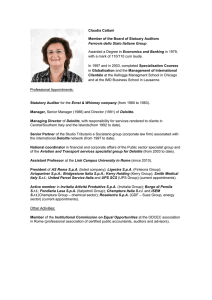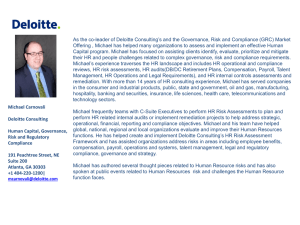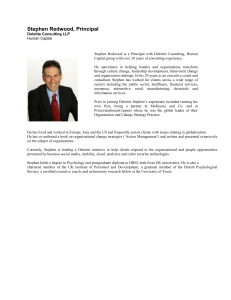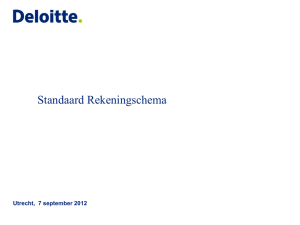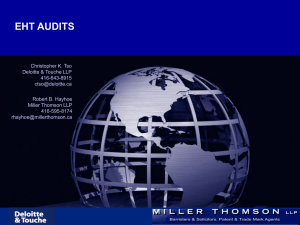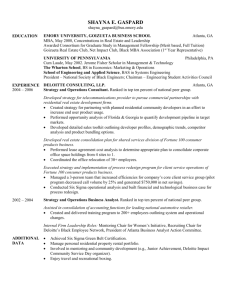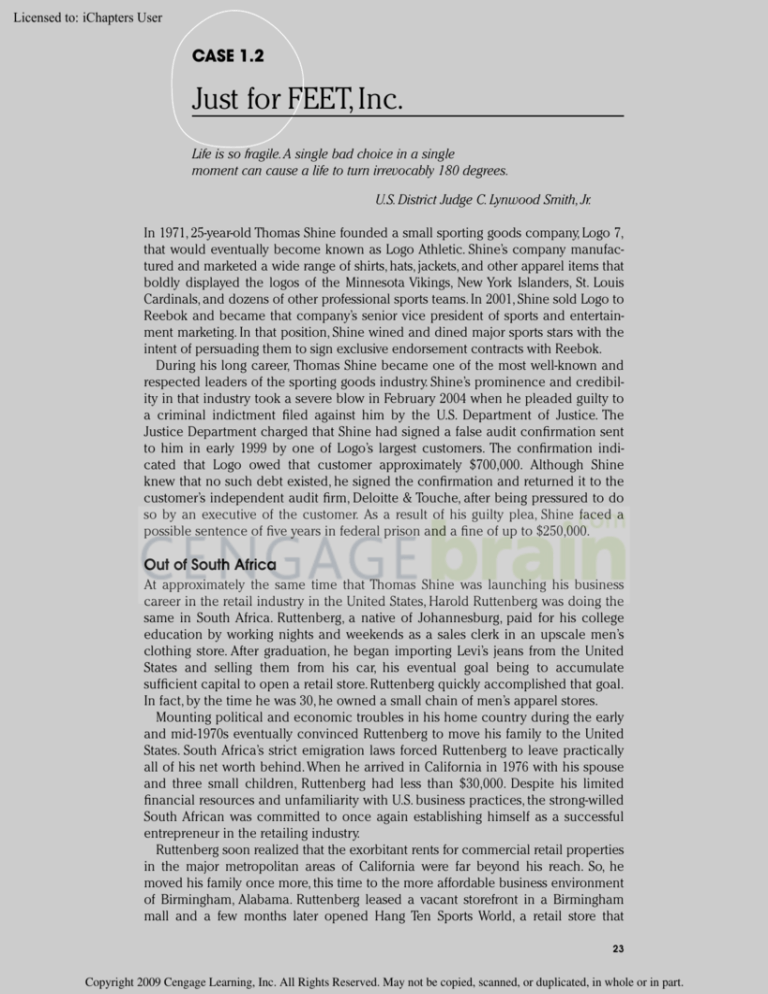
Licensed to: iChapters User
CASE 1.2
Just for FEET, Inc.
Life is so fragile.A single bad choice in a single
moment can cause a life to turn irrevocably 180 degrees.
U.S. District Judge C. Lynwood Smith, Jr.
In 1971, 25-year-old Thomas Shine founded a small sporting goods company, Logo 7,
that would eventually become known as Logo Athletic. Shine’s company manufactured and marketed a wide range of shirts, hats, jackets, and other apparel items that
boldly displayed the logos of the Minnesota Vikings, New York Islanders, St. Louis
Cardinals, and dozens of other professional sports teams. In 2001, Shine sold Logo to
Reebok and became that company’s senior vice president of sports and entertainment marketing. In that position, Shine wined and dined major sports stars with the
intent of persuading them to sign exclusive endorsement contracts with Reebok.
During his long career, Thomas Shine became one of the most well-known and
respected leaders of the sporting goods industry. Shine’s prominence and credibility in that industry took a severe blow in February 2004 when he pleaded guilty to
a criminal indictment filed against him by the U.S. Department of Justice. The
Justice Department charged that Shine had signed a false audit confirmation sent
to him in early 1999 by one of Logo’s largest customers. The confirmation indicated that Logo owed that customer approximately $700,000. Although Shine
knew that no such debt existed, he signed the confirmation and returned it to the
customer’s independent audit firm, Deloitte & Touche, after being pressured to do
so by an executive of the customer. As a result of his guilty plea, Shine faced a
possible sentence of five years in federal prison and a fine of up to $250,000.
Out of South Africa
At approximately the same time that Thomas Shine was launching his business
career in the retail industry in the United States, Harold Ruttenberg was doing the
same in South Africa. Ruttenberg, a native of Johannesburg, paid for his college
education by working nights and weekends as a sales clerk in an upscale men’s
clothing store. After graduation, he began importing Levi’s jeans from the United
States and selling them from his car, his eventual goal being to accumulate
sufficient capital to open a retail store. Ruttenberg quickly accomplished that goal.
In fact, by the time he was 30, he owned a small chain of men’s apparel stores.
Mounting political and economic troubles in his home country during the early
and mid-1970s eventually convinced Ruttenberg to move his family to the United
States. South Africa’s strict emigration laws forced Ruttenberg to leave practically
all of his net worth behind. When he arrived in California in 1976 with his spouse
and three small children, Ruttenberg had less than $30,000. Despite his limited
financial resources and unfamiliarity with U.S. business practices, the strong-willed
South African was committed to once again establishing himself as a successful
entrepreneur in the retailing industry.
Ruttenberg soon realized that the exorbitant rents for commercial retail properties
in the major metropolitan areas of California were far beyond his reach. So, he
moved his family once more, this time to the more affordable business environment
of Birmingham, Alabama. Ruttenberg leased a vacant storefront in a Birmingham
mall and a few months later opened Hang Ten Sports World, a retail store that
23
Copyright 2009 Cengage Learning, Inc. All Rights Reserved. May not be copied, scanned, or duplicated, in whole or in part.
Licensed to: iChapters User
24
SECTION ONE
COMPREHENSIVE CASES
marketed children’s sportswear products. Thanks largely to his work ethic and
intense desire to succeed, Ruttenberg’s business prospered over the next decade.
In 1988, Ruttenberg decided to take a gamble on a new business venture. Ruttenberg
had come to believe that there was an opportunity to make large profits in the retail
shoe business. At the time, the market for high-priced athletic shoes—basketball shoes,
in particular—was growing dramatically and becoming an ever-larger segment of the retail shoe industry. The principal retail outlets for the shoes produced by Adidas, Nike,
Reebok, and other major athletic shoe manufacturers were relatively small stores
located in thousands of suburban malls scattered across the country, meaning that the
retail athletic shoe“subindustry”was highly fragmented. The five largest retailers in this
market niche accounted for less than 10 percent of the annual sales of athletic shoes.
Ruttenberg realized that the relatively small floor space of retail shoe stores in
suburban malls limited a retailer’s ability to display the wide and growing array of
products being produced by the major shoe manufacturers. Likewise, the high cost
of floor space in malls with heavy traffic served to limit the profitability of shoe
retailers. To overcome these problems, Ruttenberg decided that he would build
freestanding shoe “superstores” located near malls. To lure consumers away from
mall-based shoe stores, Ruttenberg developed a three-pronged business strategy
focusing on “selection,”“service,” and “entertainment.”
The business plan Ruttenberg developed for his superstores involved a storeswithin-a-store concept; that is, he intended to create several mini-stores in his large retail outlets, each of which would be devoted exclusively to the products of individual
shoe manufacturers. He believed this store design would appeal to both consumers
and vendors. Consumers who were committed to one particular brand would not
have to search through store displays that included a wide assortment of branded
products. Likewise, his proposed floor design would provide major vendors an
opportunity to participate in marketing their products. Ruttenberg hoped that his
planned floor design would spur the major vendors to compete with each other in
providing so-called vendor allowances to his superstores to make their individual
displays more attractive than those of competitors.
Customer service was the second major element of Ruttenberg’s business plan for
his shoe superstores. Ruttenberg planned to staff his stores so that there would be an
unusually large ratio of sales associates to customers. Sales associates would be required to complete an extensive training course in “footwear technology”so that they
would be well equipped to answer any questions posed by customers. When a customer chose to try on a particular shoe product, he or she would have to ask a sales
associate to retrieve that item from the “back shop.” Sales associates were trained to
interact with customers in such a way that they would earn their trust and thus
create a stronger bond with them.
Just for Feet’s 1998 Form 10-K described the third feature of Harold Ruttenberg’s business plan as creating an “Entertainment Shopping Experience.” Rock and roll music
and brightly colored displays greeted customers when they entered the superstores.
When they were tired of shopping, customers could play a game of “horse” on an
enclosed basketball half-court located near the store’s entrance or sit back and enjoy a
multiscreen video bank in the store’s customer lounge. Frequent promotional events
included autograph sessions with major sports celebrities such as Bart Starr, the former
Green Bay Packers quarterback who was also on the company’s board of directors.
Ruttenberg would eventually include two other key features in the floor plans
of his superstores. Although Just for Feet did not target price-conscious customers,
Ruttenberg added a “Combat Zone” to each superstore where such customers could
rummage through piles of discontinued shoe lines,“seconds,” and other discounted
Copyright 2009 Cengage Learning, Inc. All Rights Reserved. May not be copied, scanned, or duplicated, in whole or in part.
Licensed to: iChapters User
CASE 1.2
JUST FOR FEET, INC.
items. For those customers who simply wanted a pair of shoes and did not have a
strong preference for a given brand, Ruttenberg developed a “Great Wall” that contained a wide array of shoes sorted not by brand but rather by function. In this large
display, customers could quickly compare and contrast the key features of dozens of
different types of running shoes, walking shoes, basketball shoes, cross-trainers, etc.
Quite a FEET
Just for Feet’s initial superstore in Birmingham proved to be a huge financial
success. That success convinced Harold Ruttenberg to open similar retail outlets
in several major metropolitan areas in the southern United States and to develop a
showcase superstore within the glitzy Caesar’s Forum shopping mall on the Las
Vegas Strip. By 1992, Just for Feet owned and operated five superstores and had
sold franchise rights for several other stores. The company’s annual sales were
approaching $20 million, but that total accounted for a nominal proportion of the
retail shoe industry’s estimated $15 billion of annual sales.
To become a major force in the shoe industry, Ruttenberg knew that he would
have to expand his retail chain nationwide, which would require large amounts of
additional capital. To acquire that capital, Ruttenberg decided to take his company
public. On March 9, 1994, Just for Feet’s common stock began trading on the NASDAQ
exchange under the ticker symbol FEET. The stock, which sold initially for $6.22 per
share, would quickly rise over the next two years to more than $37 per share.
Ruttenberg used the funds produced by Just for Feet’s initial public offering (IPO)
to pursue an aggressive expansion program. The company opened dozens of new
superstores during the mid-1990s and acquired several smaller competitors, including Athletic Attic in March 1997 and Sneaker Stadium in July 1998. For fiscal 1996,
which ended January 31, 1997, the company reported a profit of $13.9 million on
sales of $250 million. Two years later, the company earned a profit of $26.7 million on
sales of nearly $775 million. By the end of 1998, Just for Feet was the second largest
athletic shoe retailer in the United States with 300 retail outlets.
During the mid-1990s, Just for Feet’s common stock was among the most closely
monitored and hyped securities on Wall Street. Analysts and investors tracking the
stock marveled at the company’s ability to consistently outperform its major competitors. By the late 1990s, market saturation and declining profit margins were
becoming major concerns within the athletic shoe segment of the shoe industry.
Despite the lackluster profits and faltering revenue growth trends of other athletic
shoe retailers, Harold Ruttenberg continued to issue press releases touting his
company’s record profits and steadily growing sales. Most impressive was the company’s 21 straight quarterly increases in same-store sales through the fourth quarter
of fiscal 1998.
In November 1997, Delphi Investments released a lengthy analytical report focusing on Just for Feet’s future prospects. In that report, which included a strong “buy”
recommendation for the company’s common stock, Delphi commented on the
“Harold Ruttenberg factor.” The report largely attributed the company’s financial success and rosy future to “the larger-than-life founder and inventor of the Just for Feet
concept.”
In frequent interviews with business journalists, Harold Ruttenberg was not timid
in discussing the huge challenges that he had personally overcome to establish himself as one of the leading corporate executives in the retail apparel industry. Nor was
Ruttenberg reluctant to point out that he had sketched out the general framework of
Just for Feet’s successful business plan over a three-day vacation in the late 1980s.
After being named one of 1996’s Retail Entrepreneurs of the Year, Ruttenberg noted
Copyright 2009 Cengage Learning, Inc. All Rights Reserved. May not be copied, scanned, or duplicated, in whole or in part.
25
Licensed to: iChapters User
26
SECTION ONE
COMPREHENSIVE CASES
that Just for Feet had succeeded principally because of the unique marketing strategies he had developed for the company. “Customers love our stores because they are
so unique. We are not a copycat retailer. Nobody does what we do, the way we do
it. The proof is in our performance.”1 In this same interview, Ruttenberg reported
that he had never been tempted to check out a competitor’s store. “I have nothing
to learn from them. I’m certainly not going to copy anything they are doing.”2
Finally, Ruttenberg did not dispute, or apologize for, his reputation as a domineering, if not imposing, superior. “I can be a very demanding, difficult boss. But I
know how to build teams. And I have made a lot of people very rich.”3
Ruttenberg realized that one of his primary responsibilities was training a new
management team to assume the leadership of the company following his retirement. “As the founder, my job is to put the right people in place for the future. I’m
preparing this company for 25 years down the road when I won’t be here.”4 One of
the individuals who Ruttenberg handpicked to lead the company into the future was
his son, Don-Allen Ruttenberg, who shared his father’s single-minded determination
and tenacious business temperament. In 1997, at the age of 29, Don-Allen Ruttenberg
was named Just for Feet’s Vice President of New Store Development. Two years later,
the younger Ruttenberg was promoted to the position of Executive Vice President.
Similar to most successful companies, Just for Feet’s path to success was not without occasional pitfalls. In 1995,Wall Street’s zeal for Just for Feet’s common stock was
tempered somewhat by an accounting controversy involving “store opening” costs.
Throughout its existence, Just for Feet had accumulated such costs for each new
store in an asset account and then amortized the costs over the 12-month period
following the store’s grand opening. A more common practice within the retail
industry was to expense such costs in the month that a new store opened. Criticism
of Just for Feet’s accounting for store opening costs goaded company management
to adopt the industry convention, which resulted in the company recording a $2.1
million cumulative effect of a change in accounting principle during fiscal 1996.
In the summer of 1996, Wall Street took notice when Harold Ruttenberg, his wife,
Pamela, and their son, Don-Allen, sold large blocks of their Just for Feet common
stock in a secondary offering to the general public. Collectively, the three members
of the Ruttenberg family received nearly $49.5 million from the sale of those securities. Major investors and financial analysts questioned why the Ruttenbergs
would dispose of much of their Just for Feet stock while, at the same time, the senior
Ruttenberg was issuing glowing projections of the company’s future prospects.
Clay Feet
No one could deny the impressive revenue and profit trends that Just for Feet established during the mid- and late 1990s. Exhibit 1 and Exhibit 2, which present the company’s primary financial statements for the three-year period fiscal 1996 through
fiscal 1998, document those trends. However, hidden within the company’s financial
data for that three-year period was a red flag. Notice in the statements of cash flows
shown in Exhibit 2 that, despite the rising profits Just for Feet reported in the late
1990s, the company’s operating cash flows during that period were negative. By early
1999, these negative operating cash flows posed a huge liquidity problem for the
1.
2.
3.
4.
Chain Store Age, “Retail Entrepreneurs of the Year: Harold Ruttenberg,” December 1996, 68.
Ibid.
Ibid.
Ibid.
Copyright 2009 Cengage Learning, Inc. All Rights Reserved. May not be copied, scanned, or duplicated, in whole or in part.
Licensed to: iChapters User
CASE 1.2
JUST FOR FEET, INC.
27
EXHIBIT 1
JUST FOR FEET, INC.
BALANCE SHEETS (000s omitted)
JUST FOR FEET,
INC., 1996–1998
BALANCE SHEETS
1999
January 31,
1998
1997
$ 12,412
$ 82,490
$138,785
—
18,875
399,901
18,302
449,490
—
15,840
206,128
6,709
311,167
33,961
6,553
133,323
2,121
314,743
160,592
71,084
8,230
$689,396
94,529
36,106
6,550
$448,352
54,922
—
6,169
$375,834
$
—
100,322
24,829
902
$ 90,667
51,162
9,292
1,363
$100,000
38,897
5,487
425
6,639
132,692
3,222
155,706
2,105
146,914
Long-term debt and obligations
Total liabilities
230,998
$363,690
24,562
$180,268
10,364
$157,278
Shareholders’ equity:
Common stock
Paid-in capital
Retained earnings
Total shareholders’ equity
3
249,590
76,113
325,706
3
218,616
49,465
268,084
3
190,492
28,061
218,556
$689,396
$448,352
$375,834
Current assets:
Cash and cash equivalents
Marketable securities
available for sale
Accounts receivable
Inventory
Other current assets
Total current assets
Property and equipment, net
Goodwill, net
Other
Total assets
Current liabilities:
Short-term borrowings
Accounts payable
Accrued expenses
Income taxes payable
Current maturities of
long-term debt
Total current liabilities
Total liabilities and
shareholders’ equity
company. To address this problem, Just for Feet sold $200 million of high-yield or
so-called “junk” bonds in April 1999.
A few weeks after selling the junk bonds, Just for Feet issued an earnings warning.
This press release alerted investors that the company would likely post its first-ever
quarterly loss during the second quarter of fiscal 1999. One month later, Just for Feet
shocked its investors and creditors when it announced that it might default on its
first interest payment on the $200 million of junk bonds. Investors received more
disturbing news in July 1999 when Harold Ruttenberg unexpectedly resigned as Just
for Feet’s CEO. The company replaced Ruttenberg with a corporate turnaround
specialist, Helen Rockey. Upon resigning, Ruttenberg insisted that Just for Feet’s financial problems were only temporary and that the company would likely post a profit
during the third quarter of fiscal 1999.
Copyright 2009 Cengage Learning, Inc. All Rights Reserved. May not be copied, scanned, or duplicated, in whole or in part.
Licensed to: iChapters User
28
SECTION ONE
COMPREHENSIVE CASES
Harold Ruttenberg’s statement did not reassure investors. The company’s stock
price went into a freefall during the spring and summer of 1999, slipping to near $4
per share by the end of July. In September, the company announced that it had lost
$25.9 million during the second quarter of fiscal 1999, a much larger loss than had
been expected by Wall Street. Less than two months later, on November 2, 1999, the
company shocked its investors and creditors once more when it filed for Chapter 11
bankruptcy protection in the federal courts.
Just for Feet’s startling collapse over a period of a few months sparked a flurry of
lawsuits against the company and its executives. Allegations of financial mismanagement and accounting irregularities triggered investigations of the company’s financial affairs by state and federal law enforcement authorities, including the Alabama
Securities Commission, the FBI, the Securities and Exchange Commission (SEC), and
the U.S. Department of Justice. In May 2003, the Justice Department announced that
a former Just for Feet executive, Adam Gilburne, had pleaded guilty to conspiracy
to commit wire and securities fraud. Gilburne, who had served in various executive
positions with Just for Feet, revealed that he and other members of the company’s
top management had conspired to inflate the company’s reported earnings from
1996 through 1999.
EXHIBIT 2
JUST FOR FEET, INC.
CONSOLIDATED STATEMENTS OF EARNINGS (000s omitted)
JUST FOR FEET,
INC., 1996–1998
INCOME STATEMENTS
AND STATEMENTS OF
CASH FLOWS
Net sales
Cost of sales
Gross profit
Other revenues
Operating expenses:
Store operating
Store opening costs
Amortization of intangibles
General and administrative
Total operating expenses
Operating income
1999
Year Ended January 31,
1998
1997
$774,863
452,330
322,533
$478,638
279,816
198,822
$256,397
147,526
108,871
1,299
1,101
581
232,505
13,669
2,072
24,341
272,587
51,245
139,659
6,728
1,200
18,040
165,627
34,296
69,329
11,240
180
7,878
88,627
20,825
Interest expense
Interest income
Earnings before income taxes and
cumulative effect of change in
accounting principle
(8,059)
143
(1,446)
1,370
43,329
34,220
24,743
Provision for income taxes
16,681
12,817
8,783
Earnings before cumulative
effect of a change in
accounting principle
26,648
21,403
15,960
—
—
(2,041)
Cumulative effect on prior years
of change in accounting principle
Net earnings
$ 26,648
$ 21,403
(832)
4,750
$ 13,919
Copyright 2009 Cengage Learning, Inc. All Rights Reserved. May not be copied, scanned, or duplicated, in whole or in part.
Licensed to: iChapters User
CASE 1.2
JUST FOR FEET, INC.
29
EXHIBIT 2—
continued
JUST FOR FEET, INC.
CONSOLIDATED STATEMENTS OF CASH FLOWS (000s omitted)
Year Ended January 31,
1999
1998
1997
Operating activities:
Net earnings
Adjustments to reconcile net earnings to net
cash used by operating activities:
Cumulative effect of a change in
accounting principle
Depreciation and amortization
Deferred income taxes
Deferred lease rentals
Changes in assets and liabilities providing
(using) cash, net of effects of acquisitions:
(Increase) decrease in accounts receivable
(Increase) decrease in inventory
(Increase) decrease in other assets
Increase (decrease) in accounts payable
Increase (decrease) in accrued expenses
Increase (decrease) in income taxes payable
Net cash used by operating activities
Investing activities:
Purchases of property and equipment, net of
disposals
Acquisitions, net of cash acquired
Purchases of marketable securities
Maturities and sales of marketable securities
Net cash used for investing activities
Financing activities:
Borrowings (repayments) under credit
facilities, net
Borrowings of long-term obligations
Principal payments on long-term obligations
Proceeds from issuance of common stock, net
Proceeds from exercise of options
Net cash provided by financing activities
Net increase (decrease) in cash and equivalents
Cash and equivalents, beginning of year
Cash and equivalents, end of year
$ 26,648
$ 21,403
$ 13,919
—
16,129
12,100
2,655
—
8,783
2,194
2,111
2,041
3,971
(744)
1,456
(2,795)
(170,169)
(8,228)
34,638
7,133
(181)
(82,070)
(8,918)
(56,616)
(5,643)
7,495
2,264
543
(26,384)
(3,143)
(76,685)
271
16,628
2,709
(2,506)
(42,083)
(78,984)
(199)
—
—
(79,183)
(43,446)
(25,548)
(14,726)
51,653
(32,067)
(33,206)
—
(44,778)
63,132
(14,852)
(90,667)
291,076
(132,290)
20,000
3,056
91,175
(9,333)
12,739
(2,054)
—
804
2,156
45,000
479
(1,335)
52,900
1,822
98,866
(70,078) (56,295)
82,490
138,785
$ 12,412 $ 82,490
JUST FOR FEET,
INC., 1996–1998
INCOME STATEMENTS
AND STATEMENTS OF
CASH FLOWS
41,931
96,854
$138,785
The information [testimony provided by Gilburne] alleges that beginning in about
1996, Just for Feet’s CEO [Harold Ruttenberg] would conduct meetings at the end of
every quarter in which he would lay out analysts’ expectations of the company’s
earnings, and then draw up a list of “goods”—items which produced or added
income—and “bads”—those which reduced income. The information alleges that
the CEO directed Just for Feet’s employees to increase the “goods” and decrease
the “bads” in order to meet his own earnings expectations and those of Wall Street
analysts.5
5. U.S. Department of Justice, “Former ‘Just for Feet, Inc.’ Executive Pleads Guilty to Conspiracy to
Commit Wire, Securities Fraud,” http://www.usdoj.gov, 12 May 2003.
Copyright 2009 Cengage Learning, Inc. All Rights Reserved. May not be copied, scanned, or duplicated, in whole or in part.
Licensed to: iChapters User
30
SECTION ONE
COMPREHENSIVE CASES
Approximately two years following Gilburne’s guilty plea,the SEC issued a series of enforcement releases that documented the three key facets of the fraudulent scheme
perpetrated by Just for Feet’s management team.“Just for Feet falsified its financial
statements by (1) improperly recognizing unearned and fictitious receivables from its
vendors, (2) failing to properly account for excess inventory, and (3) improperly
recording as income the value of display booths provided by its vendors.”6
As noted earlier, the stores-within-a-store floor plan developed by Harold Ruttenberg provided an opportunity for Just for Feet’s vendors to become directly involved
in the marketing of their products within the company’s superstores. Each year, Just
for Feet received millions of dollars of “vendor allowances” or “advertising co-op”
from Adidas, Converse, Nike, Reebok, and its other major suppliers. These allowances
were intended to subsidize Just for Feet’s advertising expenditures for its superstores.
Despite the large size of the vendor allowances, there was typically not a written
agreement that documented the conditions under which Just for Feet was entitled to
an allowance. Instead, an account manager of each vendor generally had considerable discretion in determining the size and timing of the allowances to be granted to
Just for Feet. After Just for Feet had run a series of advertisements or other promotional announcements for a vendor’s product, copies of the advertising materials
would be submitted to the vendor. The vendor would then pay Just for Feet an
allowance based largely upon the amount of the advertised products that the
company had purchased.
Generally accepted accounting principles (GAAP) dictated that vendor allowances not be offset against advertising expenses until the given advertisements
had been run or other promotional efforts had been completed. However, Just for
Feet began routinely recording anticipated vendor allowances as receivables and advertising expense offsets well before the related advertising or promotional programs
had been completed. Just for Feet’s management team was particularly aggressive in
“frontloading”vendor allowances during fiscal 1998.At the end of fiscal 1997, Just for
Feet had slightly more than $400,000 of outstanding vendor allowance receivables;
12 months later, at the end of fiscal 1998, that total had soared to almost $29 million.7
During fiscal 1998, Just for Feet’s merchandise inventory nearly doubled, rising
from $206 million on January 31, 1998, to almost $400 million on January 31, 1999.Although Just for Feet had a large amount of slow-moving inventory, the company’s
management team refused to properly apply the lower of cost or market rule in arriving at a year-end valuation reserve for that important asset. As a result, at the end of
both fiscal 1997 and fiscal 1998, the company’s allowance for inventory obsolescence stood at a nominal $150,000.
The major athletic shoe vendors frequently erected promotional displays or
booths in the Just for Feet superstores. These booths were maintained by sales representatives of the vendors and were the property of those vendors. In early 1998, DonAllen Ruttenberg concocted a fraudulent scheme to produce millions of dollars of
“booth income” for Just for Feet. Without the knowledge of its vendors, Just for Feet
began recording in its accounting records monthly booth income amounts allegedly
earned from those vendors. The offsets to these revenue amounts for accounting
6. U.S. Securities and Exchange Commission, “SEC Charges Deloitte & Touche and Two of Its Personnel
for Failures in Their Audits of Just for Feet,” http://www.sec.gov, 26 April 2005.
7. Although technically receivables, the vendor allowances purportedly due to Just for Feet were netted
against the given vendor’s accounts payable balance, which explains why these receivables do not appear
explicitly in the company’s balance sheets shown in Exhibit 1.
Copyright 2009 Cengage Learning, Inc. All Rights Reserved. May not be copied, scanned, or duplicated, in whole or in part.
Licensed to: iChapters User
CASE 1.2
JUST FOR FEET, INC.
purposes were booked (debited) to a booth assets account.8 By the end of fiscal
1998, Just for Feet had recorded $9 million of bogus assets and related revenues as a
result of this scheme. More than 80 percent of these bogus transactions were
recorded during the final two quarters of fiscal 1998, ostensibly to allow Just for Feet
to reach its previously announced earnings targets for those two periods.
An important feature of the Just for Feet accounting fraud was Don-Allen Ruttenberg’s
close relationships with key executives of the major athletic shoe vendors. Since
Just for Feet was among the largest customers of each of these vendors, the company
had a significant amount of economic leverage on those executives. The younger
Ruttenberg used this leverage to persuade those executives to return false confirmations to Just for Feet’s independent audit firm, Deloitte & Touche. Those confirmations were sent to Just for Feet’s vendors to confirm bogus receivables that were a
product of the company’s fraudulent accounting scheme. In most cases, the bogus
receivables resulted from inflated or otherwise improper vendor allowances booked
by Just for Feet. One of the five vendor executives who capitulated to Don-Allen
Ruttenberg’s demands was Thomas Shine, the senior executive of Logo Athletic. Executives of four Just for Feet vendors steadfastly refused to provide false confirmations
to Deloitte. Those executives were employed by Asics-Tiger, New Balance, Reebok,
and Timberland. Ironically, in 2001, Thomas Shine became an executive of Reebok
when that company purchased Logo Athletic.
Footing & Cross-Footing
Deloitte & Touche served as Just for Feet’s independent audit firm from 1992 through
early December 1999, one month after the company filed for Chapter 11 bankruptcy.
Deloitte issued unqualified audit opinions each year on Just for Feet’s financial statements, including the financial statements in the S-1 registration statement the company filed with the SEC when it went public in 1994.
Steven Barry served as Just for Feet’s engagement partner for the fiscal 1998 audit.
Barry was initially an employee of Touche Ross & Co. and was promoted to partner
with that firm in 1988. The next year, Barry became a Deloitte & Touche partner
following the merger of Touche Ross with Deloitte, Haskins, & Sells. In 1996, Barry was
promoted to managing partner of Deloitte’s Birmingham, Alabama office. Barry’s
principal subordinate on the 1998 Just for Feet audit was Karen Baker, who had been
assigned to the company’s audit engagement team since 1993. Initially the audit
senior on that engagement team, she became the engagement audit manager after
being promoted to that rank in 1995.
Deloitte assigned a “greater than normal” level of audit risk to the fiscal 1998 Just
for Feet audit during the planning phase of that engagement. To help monitor highrisk audit engagements, Deloitte had established a “National Risk Management
Program.” In both 1997 and 1998, Just for Feet was included in that program. Each
client involved in this program was assigned a “National Review Partner.” This partner’s duties included “discussing specific risk areas and plans to respond to them, . . .
reviewing the audit workpapers concerning risk areas of the engagement, and
reviewing the financial statements and Deloitte’s audit reports with an emphasis on
the identification of specific risk areas as well as the adequacy of the audit report
and disclosures regarding these risk areas.”9
8. This fraudulent scheme actually replaced a similar but smaller-scale scam that the younger Ruttenberg
had used since December 1996 to inflate Just for Feet’s operating results.
9. Securities and Exchange Commission, Accounting and Auditing Enforcement Release No. 2238,
26 May 2005. Unless noted otherwise, the remaining quotations in this case were taken from this source.
Copyright 2009 Cengage Learning, Inc. All Rights Reserved. May not be copied, scanned, or duplicated, in whole or in part.
31
Licensed to: iChapters User
32
SECTION ONE
COMPREHENSIVE CASES
The audit workpapers for the fiscal 1997 audit identified several specific audit risk
factors. These factors included “management accepts high levels of risk,” “places
significant emphasis on earnings,” and “has historically interpreted accounting standards aggressively.” Another 1997 workpaper noted that the company’s management
team placed a heavy emphasis on achieving previously released earnings targets,
expressed an “excessive” interest in maintaining the company’s stock price at a high
level, and engaged in “unique and highly complex” transactions near fiscal year-end.
A summary 1997 workpaper entitled “Risk Factors Worksheet” also noted that Harold
Ruttenberg exercised “one man (autocrat) rule” over Just for Feet and that the company practiced “creative accounting.”
For both the 1997 and 1998 audit engagements, Deloitte personnel prepared a
“Client Risk Profile.” This workpaper for those two audits identified vendor
allowances and inventory valuation as key audit risk areas. In 1996, Deloitte’s headquarters office had issued a firm-wide “Risk Alert” informing practice offices that
vendor allowances should be considered a “high-risk area” for retail clients.
During the 1998 audit, the Deloitte engagement team identified several factors
that, according to the SEC, should have caused both Barry and Baker to have “heightened professional skepticism” regarding Just for Feet’s vendor allowances. The most
important of these factors was the huge increase in the vendor allowance receivables between the end of fiscal 1997 and fiscal 1998. In the final few weeks of fiscal
1998, Just for Feet recorded $14.4 million of vendor allowances, accounting for
almost one-half of the year-end balance of that account. Deloitte was never provided
with supporting documentation for $11.3 million of those vendor allowances,
although a Just for Feet executive had promised to provide that documentation.
Deloitte completed its fieldwork for the fiscal 1998 audit on April 23, 1999, almost
three months following the fiscal year-end. As of that date, Just for Feet had not
received any payments from its suppliers for the $11.3 million of undocumented
vendor allowances.
In March 1999, Deloitte mailed receivables confirmations to 13 of Just for Feet’s
suppliers. Collectively, those vendors accounted for $22 million of the $28.9 million
of year-end vendor allowances. Again, Don-Allen Ruttenberg persuaded executives
of five Just for Feet vendors to sign and return confirmations to Deloitte even though
the vendor allowance receivables listed on those confirmations did not exist or were
grossly inflated. The confirmations returned by the other eight vendors were generally “nonstandard,” according to the SEC. That is, these confirmations included
caveats, disclaimers, or other statements that should have alerted Deloitte to the possibility that the given receivable balances were unreliable. “Five vendors returned
nonstandard letters that, instead of unambiguously confirming amounts owed to Just
for Feet at the end of the fiscal 1998 year, as requested by the auditors, provided ambiguous information on amounts of co-op [vendor allowances] that the Company
had earned, accrued, or had available during the year” [emphasis added by SEC].
Another of the returned confirmations explicitly noted that “no additional funds”
were due to Just for Feet.
The eight nonstandard confirmations accounted for approximately $16 million of
the $22 million of vendor allowance receivables that Deloitte attempted to confirm
at year-end. “Despite these and other flaws, the Respondents [Deloitte, Barry, and
Baker] nonetheless accepted these letters as confirming approximately $16 million
in receivables claimed by Just for Feet.” The SEC’s investigation of Deloitte’s Just for
Feet audits revealed that although Barry and Baker accepted these flawed confirmations, two subordinates assigned to the 1998 engagement team continued to investigate the obvious discrepancies in those confirmations well after the completion of
Copyright 2009 Cengage Learning, Inc. All Rights Reserved. May not be copied, scanned, or duplicated, in whole or in part.
Licensed to: iChapters User
CASE 1.2
JUST FOR FEET, INC.
that audit. These two individuals, who were audit seniors, twice contacted a Just for
Feet executive in the months following the completion of the 1998 audit in an attempt to obtain plausible explanations for the eight nonstandard and suspicious
confirmations. That executive did not respond to the audit seniors and neither Barry,
nor Baker, apparently, insisted that he provide appropriate documentation and/or
explanations regarding the amounts in question.
Just for Feet’s large increase in inventory during fiscal 1998 presented several obvious issues for the Deloitte auditors to consider during the 1998 audit, the most important being whether the client’s reserve for inventory obsolescence was sufficient.
The primary audit procedure used by Deloitte during the 1998 audit to assess the
reasonableness of the client’s inventory valuation reserve was to obtain and test an
inventory “reserve analysis” prepared by a company vice president. This latter document was supposed to include the three classes of inventory items to which company policy required the lower of cost or market rule to be applied: (1) shoe styles
for which the company had four or fewer pairs, (2) shoes and other apparel that
were selling for less than cost, and (3) any inventory styles for which no items had
been sold during the previous 12 months. However, the reserve analysis for 1998 excluded those inventory styles for which no sales had been made during the previous
12 months, an oversight that the Deloitte auditors never questioned or investigated.
The Deloitte auditors also discovered that a large amount of inventory included in
a Just for Feet warehouse had been excluded from the reserve analysis prepared
by the company vice president. Again, the auditors chose not to question client
personnel regarding this oversight.
After completing their inventory audit procedures, the Deloitte auditors concluded
that Just for Feet’s year-end reserve for inventory obsolescence was significantly understated. The SEC noted that this conclusion was reached by the Deloitte auditors
despite the obvious deficiencies in audit procedures applied to Just for Feet’s reserve
for inventory obsolescence:
Even using the flawed inventory analysis provided by the Vice President and the deficient inventory information that excluded the goods from the New Jersey warehouse,
the Respondents concluded that Just for Feet’s obsolescence reserve should have
been in the range of $441,000 to over $1 million.
The Deloitte audit team prepared a proposed audit adjustment to increase the reserve for inventory obsolescence by more than $400,000; however, the client rejected
that audit adjustment, meaning that the year-end balance of that account remained
at a meager $150,000.
Although not specifically identified as a “key audit risk area” during the 1998 audit,
the Deloitte auditors focused considerable attention on Just for Feet’s accounting
decisions for the approximately $9 million of “booth income” the company recorded
during that year. The Deloitte auditors discovered the monthly booth income journal entries recorded by Just for Feet during fiscal 1998 and prepared a workpaper
documenting those entries. “An analysis at the end of the workpaper, which Baker
reviewed, showed that the net effect of Just for Feet’s booth-related journal entries
was to increase assets with a corresponding increase in income. The Respondents
[Deloitte, Barry, and Baker] performed no further analysis to determine the basis and
propriety of these journal entries.”
Instead of independently investigating these entries, the Deloitte auditors accepted
the representation of a Just for Feet executive who insisted that the entries had no
effect on the company’s net income. According to this executive, the monthly booth
income amounts were offset by preexisting “co-op” or advertising credits that had
Copyright 2009 Cengage Learning, Inc. All Rights Reserved. May not be copied, scanned, or duplicated, in whole or in part.
33
Licensed to: iChapters User
34
SECTION ONE
COMPREHENSIVE CASES
been granted to Just for Feet by its major vendors. In other words, instead of using
those advertising credits to reduce reported advertising expenses, Just for Feet was
allegedly converting those credits into booth income or revenue amounts.
By the end of 1998, the bogus booth income journal entries had produced $9 million of nonexistent “booth assets” in Just for Feet’s accounting records. Since “neither
the Company nor the auditors had internal evidence supporting the recording of
$9 million of booth assets,” the Deloitte engagement team decided to corroborate the
existence and ownership assertions for those assets by obtaining confirmations from
the relevant Just for Feet vendors. These confirmations were prepared with the assistance of certain Just for Feet executives who were aware of the fraudulent nature of
the booth income/booth assets amounts. Apparently, these executives contacted the
vendor representatives to whom the confirmations were mailed and told them how
to respond to the confirmations. The booth assets confirmations returned by the
vendors to Deloitte were replete with errors and ambiguous statements. A frustrated
audit senior who reviewed the confirmations brought this matter to the attention of
both Barry and Baker.
An audit senior reviewed these confirmations and informed Barry and Baker that she
was in some cases sending multiple confirmation requests to the vendors because
many of their initial requests came back in forms different from that requested. The
Respondents failed to discover from these indications that Just for Feet might not
actually . . . [own] the booths as claimed.
EPILOGUE
In February 2000, after realizing that Just for
Feet was no longer salvageable, Helen Rockey
began the process of liquidating the company
under Chapter 7 of the federal bankruptcy
code. Over the next few years, settlements were
announced to a number of large lawsuits
linked to the Just for Feet accounting fraud and
the company’s subsequent bankruptcy. Just for
Feet’s former executives and Deloitte were
among the principal defendants in those lawsuits. One of those cases, a class-action lawsuit
filed by Just for Feet’s former stockholders, was
settled for a reported $32.4 million in 2002.
Several of Just for Feet’s former executives
pleaded guilty to criminal charges for their
roles in the company’s massive accounting
fraud. Among these individuals was Don-Allen
Ruttenberg. In April 2005, a federal judge sentenced Ruttenberg to 20 months in federal
prison and fined him $50,000. At the same time
that the younger Ruttenberg’s sentence was announced, a Department of Justice official reported that Harold Ruttenberg, who was gravely
ill with brain cancer, would not be charged in
the case. In January 2006, Harold Ruttenberg
died at the age of 63.
Five executives of Just for Feet’s former vendors also pleaded guilty to various criminal
charges for providing false confirmations to the
company’s auditors. Most of these individuals,
including Thomas Shine, received probationary
sentences. An exception was Timothy McCool,
the former director of apparel sales for Adidas,
who received a four-month “noncustodial”
sentence. While sentencing McCool, U.S.
District Judge C. Lynwood Smith, Jr., noted,
“Life is so fragile. A single bad choice in a
single moment can cause a life to turn irrevocably 180 degrees. I think that is where you find
yourself.”10
10. The Associated Press State & Local Wire, “Adidas America Executive Sentenced in Just for Feet Case,”
22 March 2004.
Copyright 2009 Cengage Learning, Inc. All Rights Reserved. May not be copied, scanned, or duplicated, in whole or in part.
Licensed to: iChapters User
CASE 1.2
JUST FOR FEET, INC.
Arguably, the party to the Just for Feet scandal that received the most condemnation from
the courts and the business press was Deloitte.
In April 2005, the SEC berated the prominent
accounting firm for the poor quality of its Just
for Feet audits in Accounting and Auditing
Enforcement Release No. 2238. In that same
enforcement release, the SEC fined Deloitte
$375,000 and suspended Steven Barry from
serving on audit engagements involving SEC
registrants for two years; Karen Baker received
a one-year suspension.
On the same date that the SEC announced
the sanctions that it had imposed on Deloitte
for its Just for Feet audits, the federal agency
also revealed the sanctions that Deloitte received for its allegedly deficient audits of a
large telecommunications company, Adelphia
Communications. Similar to Just for Feet, the
once high-flying Adelphia had suddenly collapsed in 2002 following revelations that its previously issued financial statements that had
been audited by Deloitte were riddled with errors. The SEC stunned the public accounting
profession by fining Deloitte $50 million for its
role in the huge Adelphia scandal, which was
easily the largest fine ever imposed on an accounting firm by the federal agency.
35
Shortly after the SEC announced the sanctions
that it had levied on Deloitte for its Just for Feet
and Adelphia Communications audits, James
Quigley, Deloitte’s CEO, issued a press release responding to those sanctions. Quigley noted in
his press release that, “Among our most significant challenges is the early detection of fraud,
particularly when the client, its management
and others collude specifically to deceive a
company’s auditors.”11 This statement infuriated
SEC officials.An SEC spokesperson responded to
Quigley’s press release by stating that, “Deloitte
was not deceived in this case. The findings in
the order show that the relevant information was
right in front of their eyes. Deloitte just didn’t do
its job, plain and simple. They didn’t miss red
flags. They pulled the flag over their head and
claimed they couldn’t see.”12
The SEC also suggested that Quigley’s press release violated the terms of the agreement that
the agency had reached with Deloitte in settling
the Just for Feet and Adelphia cases. Under the
terms of that agreement, Deloitte was not required to “admit” to the SEC’s findings, nor was
it allowed to “deny” those findings. Deloitte subsequently rescinded Quigley’s press release and
issued another that eliminated some, but not all,
of the statements that had offended the SEC.
Questions
1. Prepare common-sized balance sheets and income statements for Just for Feet
for the period 1996–1998. Also compute key liquidity, solvency, activity, and
profitability ratios for 1997 and 1998. Given these data, comment on what you
believe were the high-risk financial statement items for the 1998 Just for Feet
audit.
2. Just for Feet operated large, high-volume retail stores. Identify internal control
risks common to such businesses. How should these risks affect the audit
planning decisions for such a client?
3. Just for Feet operated in an extremely competitive industry, or subindustry.
Identify inherent risk factors common to businesses facing such competitive
11. Stephen Laub, “Deloitte Statement Irks SEC,” CFO.com, 28 April 2005.
12. Siobhan Hughes, “SEC Rebukes Deloitte over Spin of Adelphia Audit,” The Associated Press State &
Local Wire, 27 April 2005.
Copyright 2009 Cengage Learning, Inc. All Rights Reserved. May not be copied, scanned, or duplicated, in whole or in part.
36
SECTION ONE
COMPREHENSIVE CASES
conditions. How should these risks affect the audit planning decisions for such
a client?
4. Prepare a comprehensive list, in a bullet format, of the audit risk factors present
for the 1998 Just for Feet audit. Identify the five audit risk factors that you believe
were most critical to the successful completion of that audit. Rank these risk
factors from least to most important and be prepared to defend your rankings.
Briefly explain whether or not you believe that the Deloitte auditors responded
appropriately to the five critical audit risk factors that you identified.
5. Put yourself in the position of Thomas Shine in this case. How would you have
responded when Don-Allen Ruttenberg asked you to send a false confirmation to
Deloitte & Touche? Before responding, identify the parties who will be affected
by your decision.
Copyright 2009 Cengage Learning, Inc. All Rights Reserved. May not be copied, scanned, or duplicated, in whole or in part.

